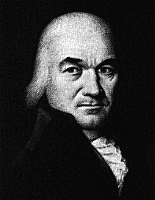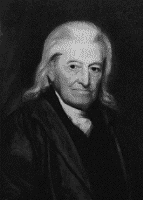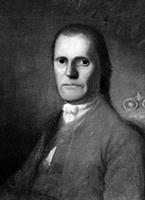![]()
 Oliver Ellsworth
Oliver Ellsworth
Connecticut
Image: Independence National Historical Park
Oliver Ellsworth was born on April 29, 1745, in Windsor, CT, to Capt. David and Jemima Ellsworth. He entered Yale in 1762 but transferred to the College of New Jersey (later Princeton) at the end of his second year. He continued to study theology and received his A.B. degree after 2 years. Soon afterward, however, Ellsworth turned to the law. After 4 years of study, he was admitted to the bar in 1771. The next year Ellsworth married Abigail Wolcott.
From a slow start Ellsworth built up a prosperous law practice. His reputation as an able and industrious jurist grew, and in 1777 Ellsworth became Connecticut's state attorney for Hartford County. That same year he was chosen as one of Connecticut's representatives in the Continental Congress. He served on various committees during six annual terms until 1783. Ellsworth was also active in his state's efforts during the Revolution. As a member of the Committee of the Pay Table, Oliver Ellsworth was one of the five men who supervised Connecticut's war expenditures. In 1779 he assumed greater duties as a member of the council of safety, which, with the governor, controlled all military measures for the state.
When the Constitutional Convention met in Philadelphia in 1787 Ellsworth once again represented Connecticut and took an active part in the proceedings. During debate on the Great Compromise, Ellsworth proposed that the basis of representation in the legislative branch remain by state, as under the Articles of Confederation. He also left his mark through an amendment to change the word "national" to "United States" in a resolution. Thereafter, "United States" was the title used in the convention to designate the government.
Ellsworth also served on the Committee of Five that prepared the first draft of the Constitution. Ellsworth favored the three-fifths compromise on the enumeration of slaves but opposed the abolition of the foreign slave trade. Though he left the convention near the end of August and did not sign the final document, he urged its adoption upon his return to Connecticut and wrote the Letters of a Landholder to promote its ratification.
Ellsworth served as one of Connecticut's first two senators in the new federal government between 1789 and 1796. In the Senate he chaired the committee that framed the bill organizing the federal judiciary and helped to work out the practical details necessary to run a new government. Ellsworth's other achievements in Congress included framing the measure that admitted North Carolina to the Union, devising the non-intercourse act that forced Rhode Island to join, drawing up the bill to regulate the consular service, and serving on the committee that considered Alexander Hamilton's plan for funding the national debt and for incorporating the Bank of the United States.
In the spring of 1796 he was appointed Chief Justice of the Supreme Court and also served as commissioner to France in 1799 and 1800. Upon his return to America in early 1801, Ellsworth retired from public life and lived in Windsor, CT. He died there on November 26, 1807, and was buried in the cemetery of the First Church of Windsor.
![]()
 William Samuel Johnson
William Samuel Johnson
Connecticut
Image: The National Portrait Gallery, Smithsonian Institution
William Samuel Johnson was the son of Samuel Johnson, the first president of King's College (later Columbia College and University). William was born at Stratford, CT, in 1727. His father, who was a well-known Anglican clergyman-philosopher, prepared him for college and he graduated from Yale in 1744. About 3 years later he won a master of arts degree from the same institution and an honorary master's from Harvard.
Resisting his father's wish that he become a minister, Johnson embraced law instead--largely by educating himself and without benefit of formal training. After admittance to the bar, he launched a practice in Stratford, representing clients from nearby New York State as well as Connecticut, and before long he established business connections with various mercantile houses in New York City. In 1749, adding to his already substantial wealth, he married Anne Beach, daughter of a local businessman. The couple was to have five daughters and six sons, but many of them died at an early age.
Johnson did not shirk the civic responsibilities of one of his station. In the 1750s he began his public career as a Connecticut militia officer. In 1761 and 1765 he served in the lower house of the colonial assembly. In 1766 and 1771 he was elected to the upper house. At the time of the Revolution, Johnson was disturbed by conflicting loyalties. Although he attended the Stamp Act Congress in 1765, moderately opposed the Townshend Duties of 1767, and believed that most British policies were unwise, he retained strong transatlantic ties and found it difficult to choose sides. Many of his friends resided in Britain; in 1765 and 1766 Oxford University conferred honorary master's and doctor's degrees upon him; he had a strong association with the Anglican Church; he acted as Connecticut's agent in Britain during the years 1767-71; and he was friendly with men such as Jared Ingersoll, Sr., who were affiliated with the British administration.
Johnson finally decided to work for peace between Britain and the colonies and to oppose the extremist Whig faction. On that basis, he refused to participate in the First Continental Congress, to which he was elected in 1774, following service as a judge of the Connecticut colonial supreme court (1772-74). When hostilities broke out, he confined his activities to peacemaking efforts. In April 1775 Connecticut sent him and another emissary to speak to British Gen. Thomas Gage about ending the bloodshed. But the time was not ripe for negotiations and they failed. Johnson fell out of favor with radical patriot elements who gained the ascendancy in Connecticut government and they no longer called upon his service. Although he was arrested in 1779 on charges of communicating with the enemy, he cleared himself and was released.
Once the passions of war had ebbed, Johnson resumed his political career. In the Continental Congress (1785-87), he was one of the most influential and popular delegates. Playing a major role in the Constitutional Convention, he missed no sessions after arriving on June 2; espoused the Connecticut Compromise; and chaired the Committee of Style, which shaped the final document. He also worked for ratification in Connecticut.
Johnson took part in the new government, in the U.S. Senate where he contributed to passage of the Judiciary Act of 1789. In 1791, the year after the government moved from New York to Philadelphia, he resigned mainly because he preferred to devote all his energies to the presidency of Columbia College (1787-1800), in New York City. During these years, he established the school on a firm basis and recruited a fine faculty.
Johnson retired from the college in 1800, a few years after his wife died, and in the same year wed Mary Brewster Beach, a relative of his first bride. They resided at his birthplace, Stratford. He died there in 1819 at the age of 92 and was buried at OldEpiscopal Cemetery.
![]()
 Roger Sherman
Roger Sherman
Connecticut
Image: The National Portrait Gallery, Smithsonian Institution
In 1723, when Sherman was 2 years of age, his family relocated from his Newton, MA, birthplace to Dorchester (present Stoughton). As a boy, he was spurred by a desire to learn and read widely in his spare time to supplement his minimal education at a common school. But he spent most of his waking hours helping his father with farming chores and learning the cobbler's trade from him. In 1743, 2 years after his father's death, Sherman joined an elder brother who had settled in New Milford, CT.
Purchasing a store, becoming a county surveyor, and winning a variety of town offices, Sherman prospered and assumed leadership in the community. In 1749 he married Elizabeth Hartwell, by whom he had seven children. Without benefit of a formal legal education, he was admitted to the bar in 1754 and embarked upon a distinguished judicial and political career. In the period 1755-61, except for a brief interval, he served as a representative in the colonial legislature and held the offices of justice of the peace and county judge. Somehow he also eked out time to publish an essay on monetary theory and a series of almanacs incorporating his own astronomical observations and verse.
In 1761, Sherman abandoned his law practice, and moved to New Haven, CT. There, he managed two stores, one that catered to Yale students, and another in nearby Wallingford. He also became a friend and benefactor of Yale College, and served for many years as its treasurer. In 1763, or 3 years after the death of his first wife, he wed Rebecca Prescott, who bore eight children.
Meanwhile, Sherman's political career had blossomed. He rose from justice of the peace and county judge to an associate judge of the Connecticut Superior Court and to representative in both houses of the colonial assembly. Although opposed to extremism, he promptly joined the fight against Britain. He supported nonimportation measures and headed the New Haven committee of correspondence.
Sherman was a longtime and influential member of the Continental Congress (1774-81 and 1783-84). He won membership on the committees that drafted the Declaration of Independence and the Articles of Confederation, as well as those concerned with Indian affairs, national finances, and military matters. To solve economic problems, at both national and state levels, he advocated high taxes rather than excessive borrowing or the issuance of paper currency.
While in Congress, Sherman remained active in state and local politics, continuing to hold the office of judge of the Connecticut Superior Court, as well as membership on the council of safety (1777-79). In 1783 he helped codify Connecticut's statutory laws. The next year, he was elected mayor of New Haven (1784-86).
Although on the edge of insolvency, mainly because of wartime losses, Sherman could not resist the lure of national service. In 1787 he represented his state at the Constitutional Convention, and attended practically every session. Not only did he sit on the Committee on Postponed Matters, but he also probably helped draft the New Jersey Plan and was a prime mover behind the Connecticut, or Great, Compromise, which broke the deadlock between the large and small states over representation. He was, in addition, instrumental in Connecticut's ratification of the Constitution.
Sherman concluded his career by serving in the U.S. House of Representatives (1789-91) and Senate (1791-93), where he espoused the Federalist cause. He died at New Haven in 1793 at the age of 72 and is buried in the Grove Street Cemetery.
back to United States' Constitution
United States' Articles of Confederation
United States' Declaration of Independence : what became of these men
Admendments
flag : including Betsy Ross' biography